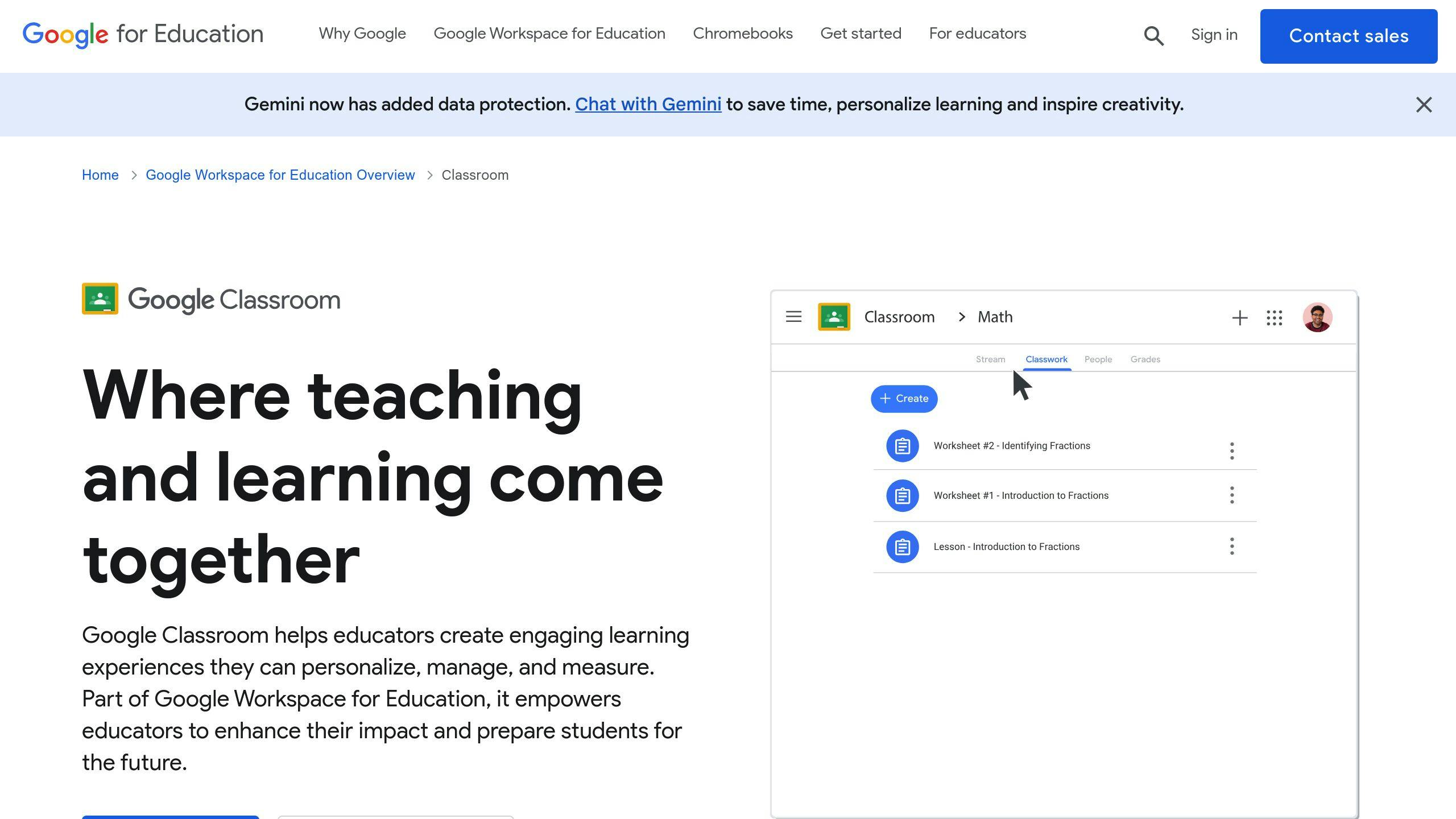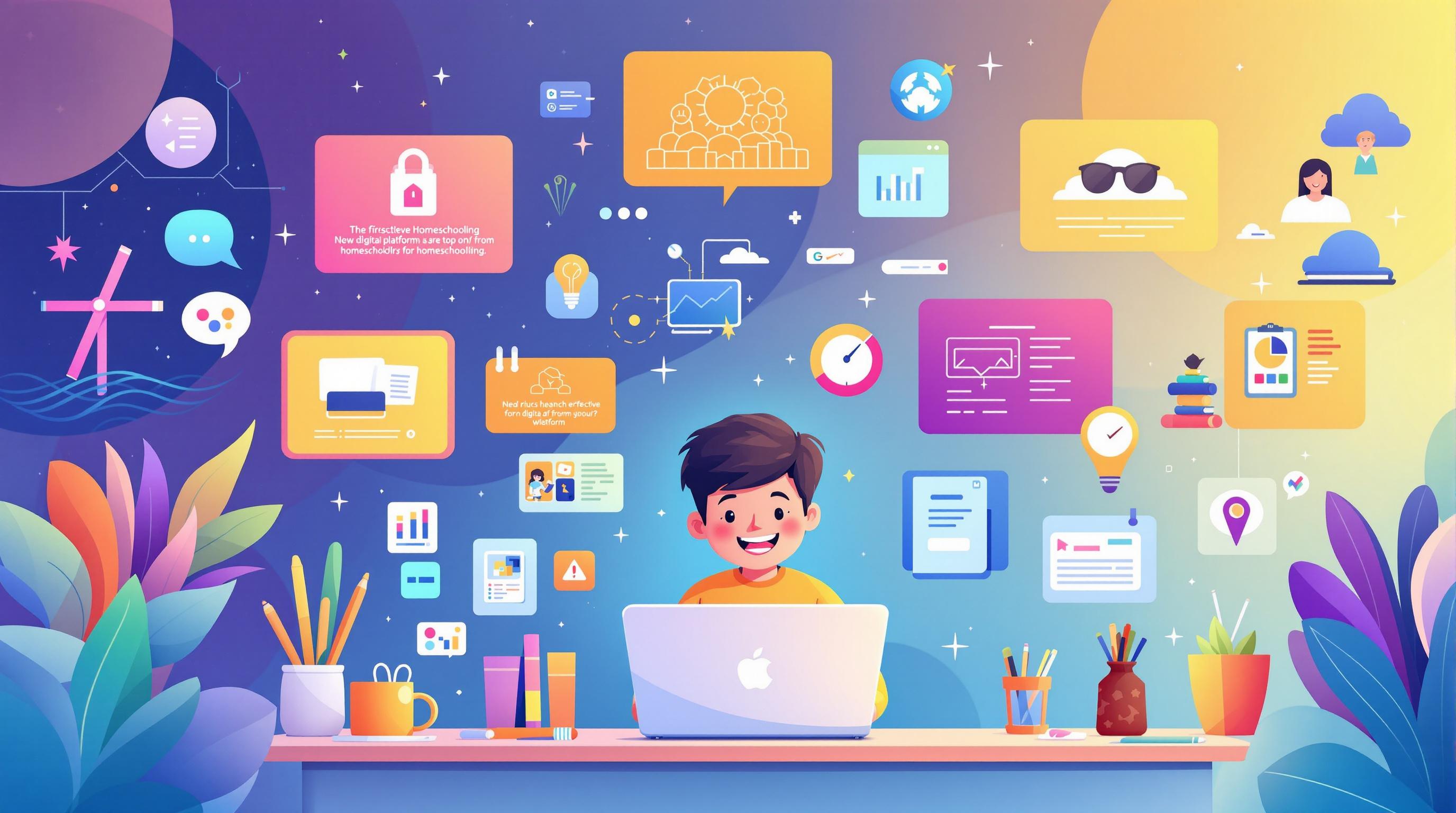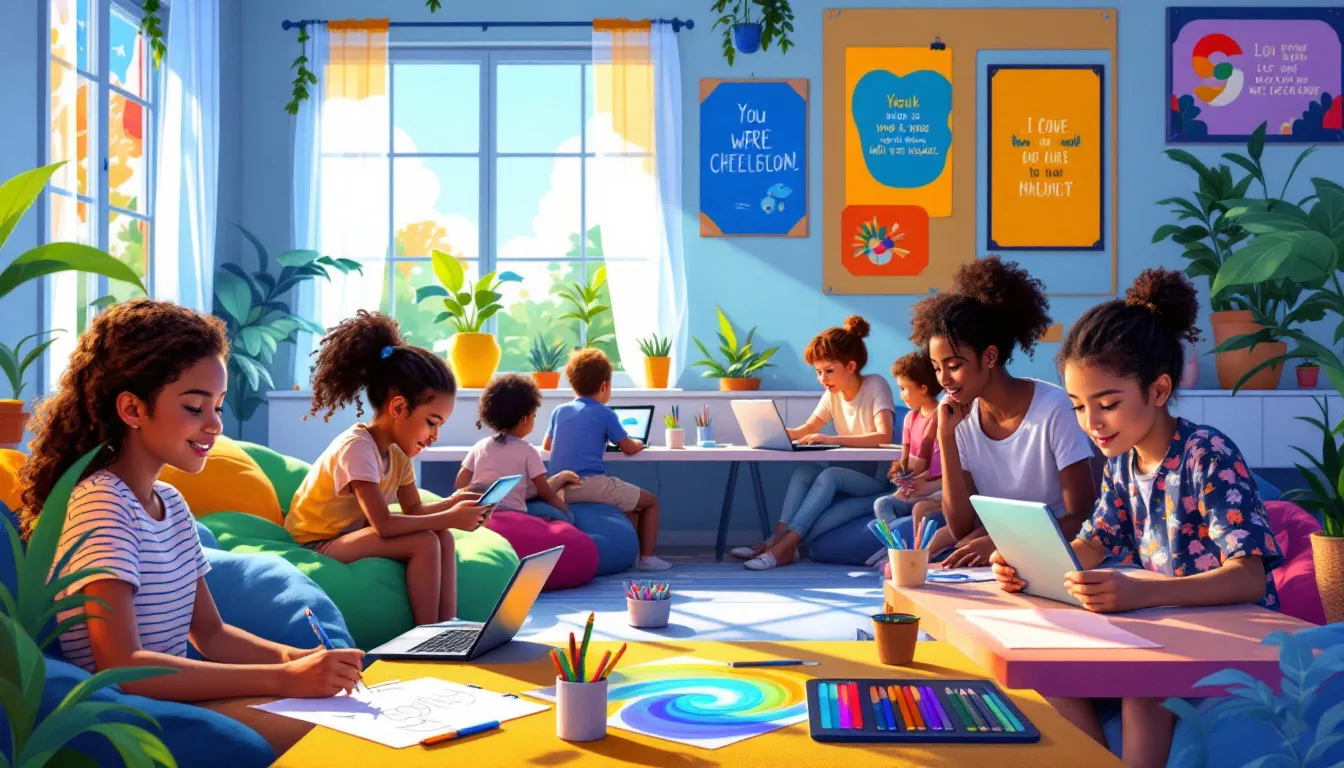Google Classroom simplifies homeschooling by organizing lessons, tracking progress, and reducing paperwork. It lets parents create digital classrooms, upload materials, assign tasks, and provide feedback - all in one place. Key features include:
- Customizable Classes: Organize by subject, student, or a single classroom for all topics.
- Lesson Management: Upload PDFs, videos, and links using Google Drive.
- Assignment Tools: Schedule tasks, set due dates, track submissions, and offer feedback.
- Personalized Learning: Tailor classes to fit individual learning styles (visual, auditory, etc.).
- Collaboration: Add co-teachers or link external resources like Khan Academy or Homeschool Directory.
Google Classroom integrates seamlessly with tools like Google Calendar and external educational platforms, making homeschooling more structured and efficient. Whether you're teaching one child or managing multiple grade levels, it streamlines your workflow and keeps everything organized.
How I use Google Classroom to Organize my Homeschool

Getting Started with Google Classroom for Homeschooling
Now that we've covered its advantages, let’s dive into setting up Google Classroom for your homeschool curriculum.
How to Create a Google Account
Start by creating Google accounts for both parents and students at accounts.google.com. For children under 13, you’ll need to use Google’s Family Link app to manage their accounts securely [1].
Setting Up Classes in Google Classroom
Open Google Classroom from your Gmail menu. Click the '+' button, select 'Create Class,' and fill in key details like the class name and subject [3]. Use the 'Topics' feature in the 'Classwork' tab to keep assignments organized. For example, you could create topics like Daily Assignments or Reading Materials.
Homeschooling families can structure their classes in a few ways:
| Organization Method | Ideal For |
|---|---|
| Single Classroom | Small families who prefer keeping all subjects in one place |
| Subject-Based | Families with multiple children studying the same subjects, making it easier to track each subject |
| Student-Based | Families with children at different grade levels, allowing for tailored learning paths |
To share responsibilities, you can add co-teachers - like tutors or other parents - through the 'People' tab [2]. For extra resources, platforms like Homeschool Directory offer curriculums and worksheets that can easily be linked to assignments in Google Classroom, making lesson planning more efficient.
Once your classes are ready, you can start uploading lesson materials and creating assignments to build out your homeschool curriculum.
Using Google Classroom to Manage Homeschool Lessons
Uploading Lesson Materials
With Google Drive integration, uploading and organizing lesson materials becomes a breeze [1]. You can share a variety of content types like PDFs, Google Docs, videos, images, and links to keep lessons engaging and varied. To keep things tidy, create topic-specific folders such as "Math Worksheets" or "Science Experiments" for easy navigation [3].
Once your materials are organized, you’re ready to create assignments that make the most of these resources.
Creating and Managing Assignments
Google Classroom offers a range of tools to help you manage assignments effectively [2]. You can include clear instructions, set due dates, assign point values, and attach files or links to external resources. From creation to submission tracking, the platform simplifies the entire process [1].
Use features like scheduling assignments in advance, tracking progress through the gradebook, and adding personalized feedback via private comments to maintain an efficient and flexible learning routine [2][3]. This setup is especially helpful for homeschooling families juggling multiple subjects and learning goals.
For extra support, platforms like Homeschool Directory provide curriculum materials that integrate seamlessly with Google Classroom. These resources can help you create a well-rounded and effective homeschool experience [1]. Once assignments are set up, you can explore additional tools to further optimize your teaching approach.
Customizing Google Classroom for Homeschooling
Setting Up Personalized Learning Plans
Google Classroom allows you to adjust learning plans to fit each child’s needs and preferences. You can create separate classes or topics for individual subjects and students. For instance, you might have a class called "Math-Advanced" for a child excelling in math while pacing other subjects differently.
Organize your Google Classroom with clear topic categories to support diverse learning methods [3].
| Learning Style | Examples |
|---|---|
| Visual | Videos, charts, interactive maps |
| Auditory | Recorded explanations, verbal quizzes |
| Reading/Writing | Essays, research projects |
| Kinesthetic | Virtual labs, DIY projects |
Once you’ve set up these tailored plans, staying informed through notifications ensures a smoother homeschooling experience.
Using Notifications and Alerts
To manage notifications, click the gear icon and customize alerts to suit your family’s schedule [4]. You can set up reminders for due dates, new materials, submissions, and comments.
For better organization, schedule notifications at times that fit your daily routine. This helps maintain consistent study habits while leaving room for extracurriculars or family time [4]. By personalizing notifications, you can keep track of each child’s progress and schedule without missing key updates.
The "Stream" tab acts as a hub for all updates and announcements, making it easier to monitor multiple subjects or students at once [3].
For extra help with planning and resources, the Homeschool Directory offers materials that work well with Google Classroom, helping you build a well-rounded educational experience.
With notifications keeping you on track, you can explore additional tools to further improve your homeschool setup.
sbb-itb-fb77983
Adding Extra Tools and Resources to Google Classroom
Using Homeschool Directory

Pairing Google Classroom with curated resources can make lesson planning and teaching more efficient. Homeschool Directory provides a range of worksheets, materials, and tools that work well with Google Classroom, helping you create a more organized and engaging curriculum.
Here’s how you can use Homeschool Directory with Google Classroom:
| Integration Method | How to Use It |
|---|---|
| Resource Integration | Attach or link worksheets and materials directly to assignments |
| Curriculum Planning | Import suggested lesson plans into your class topics |
| Community Resources | Share discussion prompts from forums to encourage student interaction |
These resources are just the start. Adding other tools can make your Google Classroom even more effective.
Integrating Other Educational Tools
Google Classroom supports a variety of external tools, letting you expand your teaching options while keeping everything in one place. Here are some popular tools and how they can be used:
| Tool Type | Examples | Best Use Case |
|---|---|---|
| Video Learning | Khan Academy | Tutorials for math and science |
| Language Learning | Duolingo | Fun and interactive language practice |
| Interactive Science | National Geographic Kids | Engaging science activities |
| Digital Libraries | Google Drive | Sharing and collaborating on documents |
To keep things organized, create specific topics in Google Classroom for each tool or resource. Look for tools that integrate directly with Google Classroom or allow simple link sharing [3]. Start with a few options that align with your teaching goals, and expand as needed [4].
Once you’ve added these tools, it’s worth considering how to streamline your workflow and tackle any potential issues.
Tips for Troubleshooting and Best Practices
Fixing Common Technical Problems
Technical hiccups while using Google Classroom for homeschooling can throw off the learning process. Here's a simple guide to tackle frequent issues:
| Issue | Solution | Prevention Tips |
|---|---|---|
| Login Problems | Clear your browser's cache, double-check login credentials, or try a different browser | Save login details securely and bookmark the login page for easy access |
| File Upload Errors | Verify the file type and ensure a stable internet connection | Stick to Google-supported formats like .doc, .pdf, or .jpg |
| Assignment Submission Issues | Check submission settings and ensure files meet size limits | Test the submission process ahead of deadlines |
If problems persist, visit the Google Classroom status page to check for service outages. The Google Classroom help center also offers detailed guides for troubleshooting specific issues.
By resolving these common technical challenges, you can keep your homeschooling workflow smooth and uninterrupted.
Improving Communication and Engagement
Clear communication and active engagement are key to making homeschooling effective with Google Classroom. Focus on these areas to keep students motivated:
Stream Management
Use the 'Pin' feature to highlight essential updates, such as assignment deadlines or schedule changes. This ensures students can easily locate important information.
Feedback Systems
| Communication Tool | Best Use |
|---|---|
| Private Comments | Provide personalized feedback on assignments |
| Class Announcements | Share weekly schedules or important updates |
| Question Posts | Facilitate group discussions and address common questions |
Organization Strategy
Label and group assignments consistently to create a clear structure. This reduces confusion and helps students find resources and tasks on their own.
Notification Setup
- Enable mobile notifications for urgent updates.
- Sync Google Classroom with your calendar to stay on top of assignment deadlines.
These practices help create a more organized and interactive homeschooling experience, ensuring students stay engaged and on track.
Conclusion: Simplifying Homeschooling with Google Classroom
Google Classroom makes homeschooling more manageable by organizing curriculum delivery and encouraging engagement. It offers a structured yet flexible approach, helping families design learning environments that suit their unique needs.
With Google Classroom, you can centralize materials, improve communication, and create personalized learning experiences. Parents can easily monitor progress and provide feedback, while students gain valuable digital literacy skills in a well-organized setting.
To get the most out of Google Classroom, keep your setup updated, make use of its built-in tools, and explore additional resources like Homeschool Directory. These steps can help you align the platform with your homeschooling goals.
Combining Google Classroom with curated resources strengthens your homeschooling plan. Homeschool Directory offers a wide range of educational materials, including worksheets and supplementary tools, that work seamlessly with Google Classroom to support your teaching objectives.
FAQs
How do I set up Google Classroom for homeschooling?
To get started, log into your Google account and go to classroom.google.com. Click the + icon in the top-right corner and choose "Create class." When prompted, select the option for personal or homeschooling use. Enter the class name, subject, and grade level to complete the setup.
Once your classroom is ready, you can customize it to fit your homeschooling approach.
Can I create separate classrooms for different subjects or children?
Absolutely! You can create individual classrooms for each subject, such as "Math 2024" or "History Lessons", or set up separate classrooms for each child. This approach helps keep assignments and materials organized while catering to your family's specific needs.
How can I manage assignments and track progress?
Use the Classwork tab to create, schedule, and organize assignments by topics or units. You can also track submissions and provide feedback directly within the platform.
Can I share classroom management with another parent or guardian?
Yes, you can add co-teachers through the People tab. This feature allows another parent or guardian to help with planning and managing assignments.
How do I include additional learning resources?
You can incorporate extra materials like YouTube videos, Google Drive files, or content from platforms like Homeschool Directory. These resources can enrich your lessons and provide a variety of learning tools.
What should I do if technical issues arise?
If you face technical problems, start by checking your internet connection, ensuring your account is verified, and clearing your browser cache. For persistent issues, the Google Classroom help center offers detailed troubleshooting steps.
These FAQs are designed to help you effectively use Google Classroom for homeschooling.


